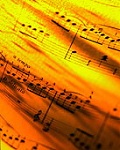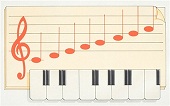
Home > Piano Chords > Charts
|
||||
Easy Piano Chord Charts
Add to this the use of ledger lines and key signatures, factor in the accidentals and double accidentals, and keep in consideration that there are three commonly used clefs, and reading music can become a huge pill to swallow. In this article, we will discuss the many benefits of piano chord charts and how you can use them to make learning to play piano an easier job. Piano charts tend to be very simple black and white diagrams of a keyboard, usually spanning a single octave of keys. Chords tend to be notated be writing out the names of the notes being used upon (for the white keys) or above (for the black keys) the designated keys. For instance, if we were to record a C Major tonic triad, which consist of the notes C, E, and G, we would notate this by writing the letters C, E, and G on their respective keys on the chart. This makes learning the chord easy, as all we have to do is copy the exact placement of the notes on our actual keys. This lesson was brought to you by Piano System
This gives you all of the room needed to create any chord within a one octave range. It is up to you if you want to write larger chords. If you do, just double the size of the keyboard. Keep in mind the placement of the black keys. When using piano chord charts, you want to pay attention to a few things. While some notes are enharmonic (such as A# and Bb), you want to keep in mind that all note properties rely on context and proper usage. This means that if you are in the chord of C Major, you don’t want to try and add sharps and flats. Likewise, if you are in Bb Major, you don’t want to notate the notes of your chords as sharps instead of flats. Always be sure to write the proper note name. This will prevent you from forgetting the chord’s properties or from overstepping the key signature. Piano chord charts can also be, in some cases, used to write patterns. This will only work if you are playing a linear, one directional pattern. If you aren’t, then it is best that you learn to transcribe sheet music instead, is you will wind up confusing yourself. If you are using a linear, one directional pattern, be sure to copy down the note values beside each respective note.
http://pianoplayerworld.com/PianoSystem.html
| ||||
|
Although every attempt has been made to make information as accurate as possible, we are not responsible for any errors that may appear.
 Reading music isn’t easy. Not only do you need to know all of your notes
beforehand, but you also need to understand their positions in accordance to the lines of the staff.
Reading music isn’t easy. Not only do you need to know all of your notes
beforehand, but you also need to understand their positions in accordance to the lines of the staff.
 While many pianists like to print out a sheet, you can make your own chord
chart easily. The most common way is to draw the keyboard from F to F. This means that you will have a total
of eight white keys. Between keys one and two, two and three, and three and four you will have black keys.
Then the black keys pick back up between keys five and six, and six and seven.
While many pianists like to print out a sheet, you can make your own chord
chart easily. The most common way is to draw the keyboard from F to F. This means that you will have a total
of eight white keys. Between keys one and two, two and three, and three and four you will have black keys.
Then the black keys pick back up between keys five and six, and six and seven.


